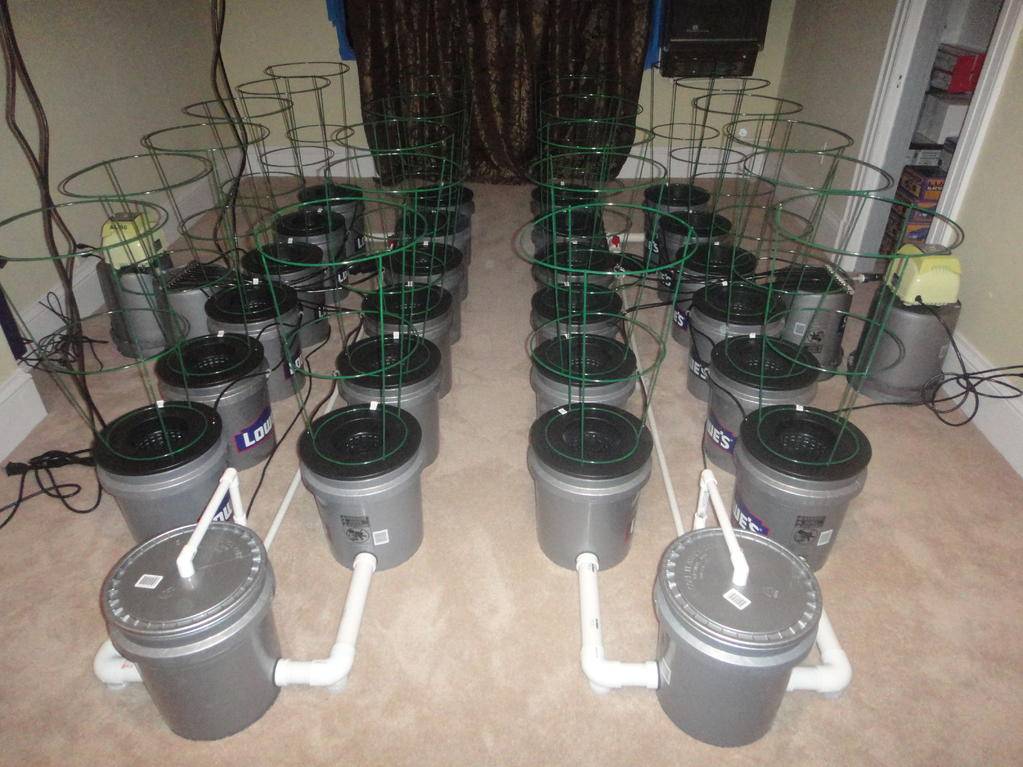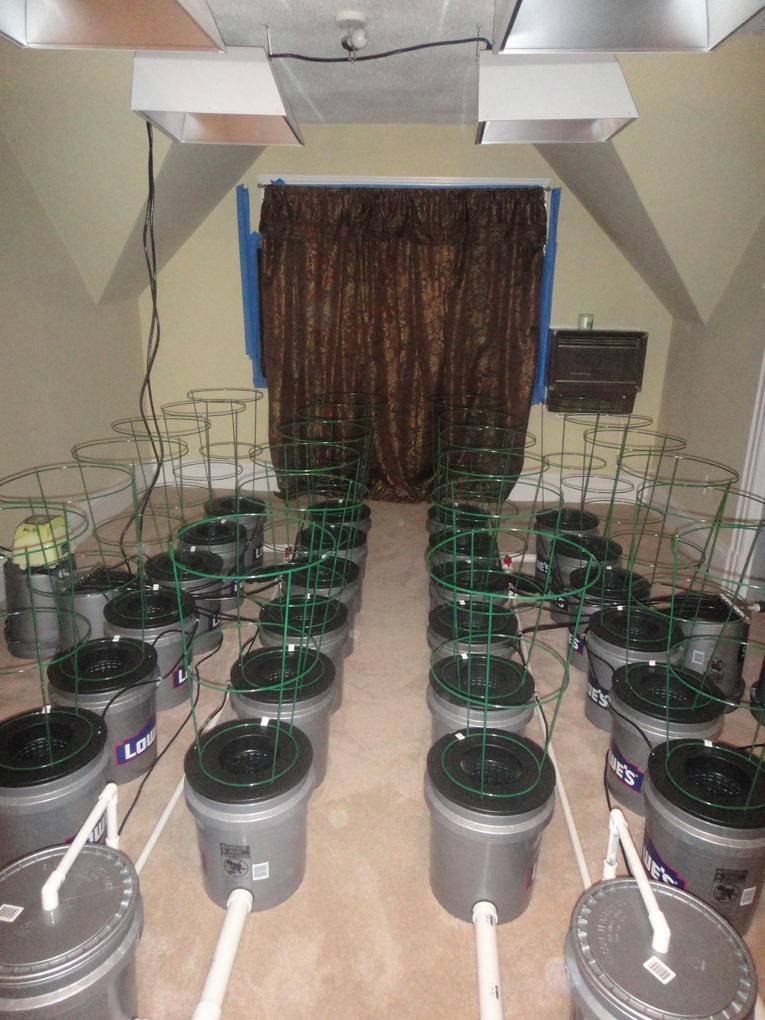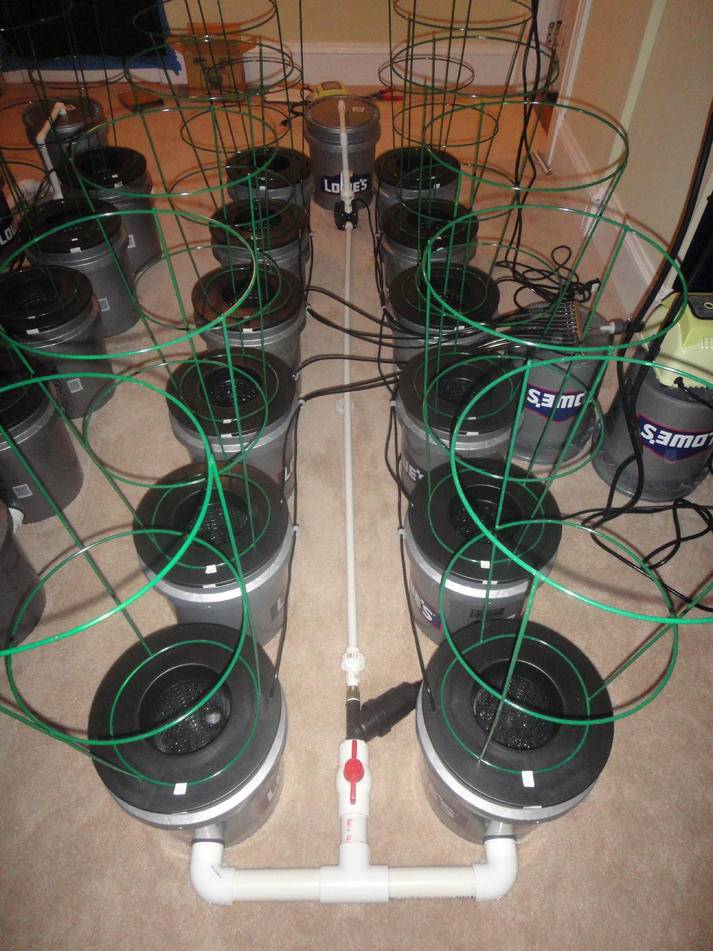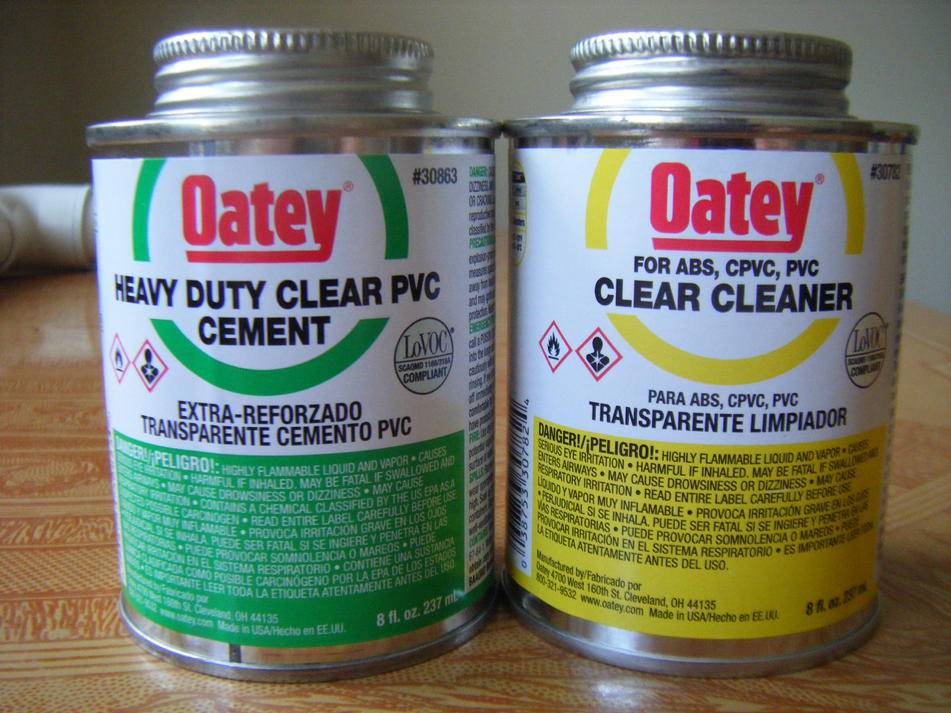This thread will be a step by step tutorial of how to build every RDWC system that you ever wanted. Why pay thousands of dollars for these types of systems from companies when you can build them yourself for cheap and it will be better than what's out there in the market. For those of you who don't feel comfortable building your own systems, I'll be offering all the parts already built sometime in June 2014. I'll give more details as I have them. This tutorial is basically done. I just need to add pictures and some minor details. The part list is all correct. Have fun with the build!
I priced out the complete part list for the 6 bucket system! You guys will be happy to know that this complete system will cost you $302.13! The 4 bucket system will cost you around $250.00 and the 12 bucket system will cost around $500.00 That price includes all your pumps and your 6" bucket lids! The only part that is not included in the price is the heavy duty tomato cages.
Isn't that amazing! You can't even buy a system for that price in stores and this system is better than any other system in the world for plants up to 55 Inches! This system has the ability to produce over 2 pounds for every 1000 watt HPS! Stay tuned...
Here is a guide how I run my RDWC systems that you can use until my official guide is posted:
Chemdog Double Diesel in RDWC - Start to finish in 1 day! Please understand that my nutrient formula has changed and I don't use the same equation in the thread below. My new formula calls for 1 part GH FloraMicro to 2 parts GH FloraBloom. I don't use anything else besides Chlorine. I got rid of the Kool Bloom and upped the FloraBloom and get much better results with the formula that I just listed. I never go over 2.2 EC in peak flowering with perfect conditions and CO2 with heavy feeders. For those who don't have CO2 and 1,000 Watt lights, I wouldn't go over 1.6 EC. I'll have many more details in my RDWC tutorial Part 2 coming in June 2014. This thread below can give you some information but it won't be as good as my part 2.
https://www.icmag.com/ic/showthread.php?t=267178
Sneak Peak of older model. I have added some changes and upgrades and will change these pictures when the tutorial is completed. Please note that the Y-Filter in the pictures below is placed backwards and is wrong. Changes were made after the pictures were taken.




An introduction to working with PVC
After cutting your PVC pipes, you will need to clean all of your PVC fittings with PVC Cleaner. Do not clean any parts that are threaded. For threaded pieces you will need to use Teflon Tape. Any piece of the pipe that has contact with another PVC piece needs to be cleaned with PVC Cleaner. Don’t just clean the pipe and remember to also clean your fittings. I like to use the Clear Cleaner because the purple one will turn your pipes purple and your system won't look as professional. Please go to YOUTUBE and watch a video on how to clean PVC fittings properly.
When you are applying the PVC Cement to your fittings, please remember to apply the Cement to both of the pieces that you are connecting. After you apply the Cement to both fittings, give the PVC pipe or fittings a quarter turn as you are inserting a piece into the other piece and make sure that the pieces go in all of the way. Let the pieces dry for 5 seconds and then you can clean any extra Cement off of the pipe/fitting. It is best to use one of the smaller cans of PVC Cement because the pipes are small and the smaller bottles of PVC Cement come with a smaller attached brush. Observe the 8 oz cans of PVC Cleaner and PVC Cement that I use in the picture below:

Warning with the Neoprene Washers
You have to be very careful when you are using the washers. Do not over tighten them to the point where they bend or flex like this picture below:
INSERT PICTURE
These washers are one time use when they are used with the grey fitting because it is actually an electrical fitting and there are raised letters on the piece of the fitting that will make an imprint onto your washers after they are screwed together. To my knowledge I don’t know of any PVC fitting that is straight and allow the fitting to screw all the way in to connect to the bucket. If you happen to know of a fitting to use instead of the grey one, please let us know and I will update this post. When I say the washers are one time use, that doesn't mean that you can't use them for years as long as you don't take the system apart. You don't need to take the system apart to clean it.
Design Change Edit:
The 12 Bucket System has been changed to a 10 Bucket System. For those growers who want to build the new 10 bucket system for 2,000 watts, on top of the new demensions of 8" on the 1.5" PVC pipe, your water pumps will need to be changed to a:
Danner Supreme Classic Model 5
And your air pump can be changed to:
Alita AL-60
This means that the price of the 2,000 Watt system just went down to under $400! Pretty amazing.
The 12 bucket system is better suited for applications which use lights similar to Gavita which gives you a 5'x5' light spread and would make the system 5'x10'. Anyone who is going to go this route, please add an additional 4" to the in-line manifolds and an extra 3" to the 2 sides of the Back Manifold. I will update the thread as soon as I can. Sometime in mid Jan 2014.
I priced out the complete part list for the 6 bucket system! You guys will be happy to know that this complete system will cost you $302.13! The 4 bucket system will cost you around $250.00 and the 12 bucket system will cost around $500.00 That price includes all your pumps and your 6" bucket lids! The only part that is not included in the price is the heavy duty tomato cages.
Isn't that amazing! You can't even buy a system for that price in stores and this system is better than any other system in the world for plants up to 55 Inches! This system has the ability to produce over 2 pounds for every 1000 watt HPS! Stay tuned...
Here is a guide how I run my RDWC systems that you can use until my official guide is posted:
Chemdog Double Diesel in RDWC - Start to finish in 1 day! Please understand that my nutrient formula has changed and I don't use the same equation in the thread below. My new formula calls for 1 part GH FloraMicro to 2 parts GH FloraBloom. I don't use anything else besides Chlorine. I got rid of the Kool Bloom and upped the FloraBloom and get much better results with the formula that I just listed. I never go over 2.2 EC in peak flowering with perfect conditions and CO2 with heavy feeders. For those who don't have CO2 and 1,000 Watt lights, I wouldn't go over 1.6 EC. I'll have many more details in my RDWC tutorial Part 2 coming in June 2014. This thread below can give you some information but it won't be as good as my part 2.
https://www.icmag.com/ic/showthread.php?t=267178
Sneak Peak of older model. I have added some changes and upgrades and will change these pictures when the tutorial is completed. Please note that the Y-Filter in the pictures below is placed backwards and is wrong. Changes were made after the pictures were taken.
An introduction to working with PVC
After cutting your PVC pipes, you will need to clean all of your PVC fittings with PVC Cleaner. Do not clean any parts that are threaded. For threaded pieces you will need to use Teflon Tape. Any piece of the pipe that has contact with another PVC piece needs to be cleaned with PVC Cleaner. Don’t just clean the pipe and remember to also clean your fittings. I like to use the Clear Cleaner because the purple one will turn your pipes purple and your system won't look as professional. Please go to YOUTUBE and watch a video on how to clean PVC fittings properly.
When you are applying the PVC Cement to your fittings, please remember to apply the Cement to both of the pieces that you are connecting. After you apply the Cement to both fittings, give the PVC pipe or fittings a quarter turn as you are inserting a piece into the other piece and make sure that the pieces go in all of the way. Let the pieces dry for 5 seconds and then you can clean any extra Cement off of the pipe/fitting. It is best to use one of the smaller cans of PVC Cement because the pipes are small and the smaller bottles of PVC Cement come with a smaller attached brush. Observe the 8 oz cans of PVC Cleaner and PVC Cement that I use in the picture below:
Warning with the Neoprene Washers
You have to be very careful when you are using the washers. Do not over tighten them to the point where they bend or flex like this picture below:
INSERT PICTURE
These washers are one time use when they are used with the grey fitting because it is actually an electrical fitting and there are raised letters on the piece of the fitting that will make an imprint onto your washers after they are screwed together. To my knowledge I don’t know of any PVC fitting that is straight and allow the fitting to screw all the way in to connect to the bucket. If you happen to know of a fitting to use instead of the grey one, please let us know and I will update this post. When I say the washers are one time use, that doesn't mean that you can't use them for years as long as you don't take the system apart. You don't need to take the system apart to clean it.
Design Change Edit:
The 12 Bucket System has been changed to a 10 Bucket System. For those growers who want to build the new 10 bucket system for 2,000 watts, on top of the new demensions of 8" on the 1.5" PVC pipe, your water pumps will need to be changed to a:
Danner Supreme Classic Model 5
And your air pump can be changed to:
Alita AL-60
This means that the price of the 2,000 Watt system just went down to under $400! Pretty amazing.
The 12 bucket system is better suited for applications which use lights similar to Gavita which gives you a 5'x5' light spread and would make the system 5'x10'. Anyone who is going to go this route, please add an additional 4" to the in-line manifolds and an extra 3" to the 2 sides of the Back Manifold. I will update the thread as soon as I can. Sometime in mid Jan 2014.
Last edited:



